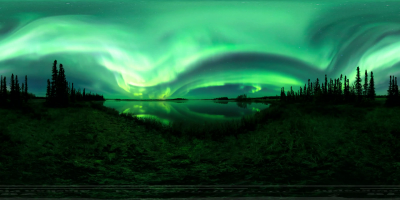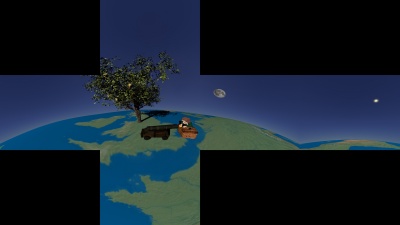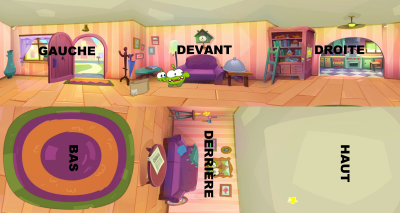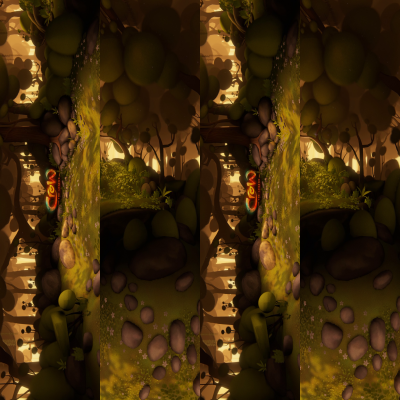Convert a
VR video VR into Fulldome
OCVWarp
: Converts VR360 videos in Fulldome, or Fulldome into warped for spherical mirror systems. Examples.
OCVVid2fulldome : Create fulldome videos withh multiple rectangular videos as source. Examples.

A so real virtual reality
What is VR? Under this acronym which designates "virtual reality" is a process involving a large pair of glasses equipped with a screen for each eye, all connected to a powerful computer capable of generating a stream at 90 images per second in order to produce a fluid animation of images depending on the direction of your gaze on a 360°x180° video scene or generated on the fly by a simulator.
The advantages of VR compared to the dome
-With such a system the user can be active, most of the time with a large number of action interfaces available. Movements in the scene may be possible over a more or less limited area.
-We can direct our gaze downwards whereas in a planetarium, we are limited to a half sphere which is directed upwards. As a result, we can view ants by looking at them from above without having the impression that the scene is upside down as it would be the case projected on a dome.
-As we no longer limit ourselves upwards, we can more easily deal with everything in good conditions. A dome, by its orientation, is predestined to display clouds, stars, flying objects or fish from the bottom of the water. It is difficult to talk about anything else without the orientation being a problem if the dome is not strongly inclined.
-The software library is naturally more extensive, especially because the market is not a niche market like for planetariums. An individual will more easily equip themselves with a VR system than with a planetarium...
-The video game market has invested heavily in this market which provides increased immersion compared to a standard screen and the player will act more naturally into the scene.
-We can technically take advantage of the fulldome film library of planetariums with such a system, which some producers are trying to democratize to benefit from lower income per unit but potentially numerous.
-A lot of content plays with where to look. This allows a dynamic and a feeling of orientation which is much better than with a projection on a dome where changing the direction from the point of view of the sky could be detrimental in recognizing the sky outdoors. Conversely, most so-called "oriented" planetarium shows do not even require turning your head, with all the action only taking place around a limited direction. In this case, we do not use the entire projection space.
-The image intended for the left eye can be distinct from that of the right eye, it is therefore possible to benefit from stereoscopic sequences. Stereoscopy in planetarium rooms is more difficult, more expensive and must be brighter because the device must be able to separate the image for each eye, which is never perfect and therefore few planetariums have invested this area. In any case, most astronomical objects are so far from the observer that stereoscopy is not really relevant (unlike VR).
Disadvantages compared to domes
-The proximity of screens requires the use of magnifying glasses which can strain your eyesight.
-Stuck in the fairly heavy helmet discomfort will soon come, and it can quickly get hot in there.
-The resolution on the screens is limited due to the concern for miniaturization inside the glasses.
-The system locks the user into a space where he will most often be the only actor. Some collaborative applications exist but are marginal because they require a multiplication of devices and therefore this will often be limited to use by participants in remote connection in mmo (massively multiplayer online).
-Prolongated use can cause headaches and dizziness when movement is quick or with jumps (while the body is not physically moving). It has been found that young people are less disturbed than adults.
-The field of view of these systems is restricted. It's like having blinders that obstruct our side vision. It's quite contradictory that a system that calls itself immersive is so limitating. From this point of view, a dome is much more immersive due to the enveloping aspect that the image provides.
-The equipment needed for an entire class is very expensive, so this can only be done with small groups and most often in turns.
-Sometimes, interaction is limited by predefined content. There are no simulators as advanced as those used in planetariums that work for VR systems to date.
-It is difficult to imagine hosting a live session with this type of system because the nature of VR is to navigate at your own pace.
-In all these aspects, it is difficult to share the same experience as your neighbor and therefore nothing justifies a group outing to benefit from this technology.
Should planetarians be worried?
In astronomy, we do not really need 3D because the celestial phenomena that we describe are always too far away for the image seen by the left eye to be distinct from that of the right eye (by forcing the relief, we inevitably mislead about the size of things). And have you ever heard during a standard session a child say “it’s 3D without glasses”? Indeed, with content in motion, the brain is able to mentally induce the distance of objects and therefore reconstruct the three-dimensional aspect of the objects it will view.
In a dome, we do not have "blinders" unlike 3D or VR glasses because of the screen areas of limited size. Of course, these screens try to increase the visual range, but the use of lenses will never allow miracles. As a result, the feeling of immersion in the image can only be convincing in hemispherical rooms. And let's not talk about the queasy feeling that VR systems can give to many people.
The playing card
The major advantage of this technology is that it allows us to benefit from the creative energy of a large number of people in our quest of getting hemispherical contents: Who can do the most (360°x180°) can do the least (360°x90°). Software is flourishing as well as content in quantity and therefore in the lot we find quality.
For example, benefiting from fisheye cameras for synthetic image rendering engines is always complicated while today, most modelers offer VR cameras by default (Cinema4D, AfterEffects, etc.).
VR formats
Due to its youth, the world of virtual reality does not offer a well-crafted standard format.
Inheriting the equirectangular format (also sometimes called spherical or latlong) specific to the mapping onto a sphere of modelers and graphics cards, it turns out that this is not very efficient because of the inhomogeneity of resolution from which the image suffers. Indeed, the pole zone is better defined than the equator. This better resolution at the poles can even prove catastrophic there because most often 3840 pixels are only supposed to represent one, which can produce flickering pixels around the polar zones.

New formats emerged to overcome these defects, using the principle of the six faces of a cube. Six contiguous image squares reproduce visual information in all directions while maintaining a relatively homogeneous resolution without concentration artifacts. The arrangement of these cubes being arbitrary, placing them in a cross like unfolded cubes would waste image pixels. The “cubefaces” illustration format used in particular by YouTube is by far the most relevant. With even the luxury of distorting the projection at the edges in order to get an homogenized resolution across the entire surface.

Another format, called cylindrical, has recently emerged. Although it is continuous over 360°, loss of pixels are encountered at some edges on the circular parts of the image, due to unused areas.
Contents exist in so-called 8K quality although most are producing only 4K the way we count them. Please note, when talking about 4K, it is in fact an image (often equirectangular) of 3840x1920 pixels resolution. 3840 pixels to cover 0 to 360° azimuth in the image and 1920 pixels to cover +90 to -90° top to bottom. This gives a fisheye resolution comparable to only 1.2K on the horizon, 1.9K on the vertical, which can be detrimental in rooms with a resolution greater than 2K. However, the further you go to the center of the image, the more the resolution increases with 2.4K at 45° height parallel to the horizon.
In the case of images with cube faces, the resolution equivalent is often 3840x2160, i.e. "squares" of 1280x1080 leading to a fisheye of 1566 pixels in diameter but almost homogeneous over the entire image. In 8K (8192x4096), this corresponds to getting a minimum resolution of 3260 pixels. Which is not so bad.

VR players for the dome
-Simulators from major manufacturers like Sky Explorer from RSA Cosmos, Digistar from Evans&Sutherland, Digital Sky, Uniview and probably others manage mapping a video texture onto a sphere.
-DigitalisMediaBrowser handles equirectangular video playback for their Universal Console-equipped systems by managing aiming direction with the Xbox controller.
-FishTank from ePlanetarium handles deformation of equirectangular videos for spherical mirror-based systems.
-ShiraPlayer allows playing equirectangular videos as animated panoramas.
-SpaceCrafter in its version integrating the Immersive Adventure Pro plugin manages equirectangular videos but also cube-face videos and also allows you to choose the orientation and compression of the field of vision using the Joypad.
What content for the planetariums
NASA offers a large quantity of royalty-free VR videos, for example in a swimming pool for astronauts training, the Juno mission, the recovery of cosmonauts from a Soyuz spacecraft, Curiosity, Spitzer, etc. (JPL):
https://informal.jpl.nasa.gov/museum/360-video
Travel into Orion nebula (STScI):
https://hubblesite.org/contents/media/videos/1013-Video.html?keyword=360
Stonehenge (English Heritage):
https://www.youtube.com/watch?v=_RyqU1r1Fmk
Northern lights in Alaska (William Briscoe):
https://www.youtube.com/channel/UCXA0I4DDGFn_0EJBmIQ_Qkw
What happened in Tunguska (Science Channel):
https://www.youtube.com/watch?v=JKm3uzL_A4c
360 degrees vision of galactic center (Chandra):
https://www.youtube.com/watch?v=wBxW2_B9_Is
And many others. Be careful, however, to ask for authorization to use it into your dome at the authors themselves. Because except for NASA where it is clearly announced as being authorized on their site, it is not the same for private productions even if they are offered to Internet users free of charge at good resolution.
Conclusion
Virtual reality will not throw the planetarium into oblivion if we take care to use our planetariums in the way that suits them best: shared experiences with a live presenter who can adapt his presentation to the needs of his audience. Using virtual reality is a chance for planetariums as we can take advantage of the emergence of this technology to transcend these contents during immersive sequences for the delight of our audiences.
|

